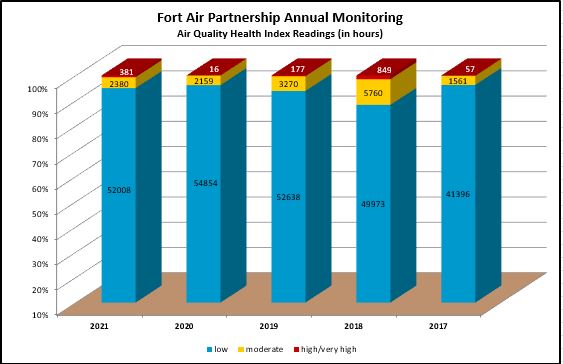Seven of Fort Air Partnership’s ten continuous monitoring stations collect data to calculate an hourly and forecast AQHI in and around Alberta’s Industrial Heartland.

Wildfire smoke was by far the most frequent contributor to high risk and very high risk Air Quality Health Index (AQHI) ratings measured at Fort Air Partnership’s monitoring stations in 2021. While the low risk AQHI ratings remained fairly static from 2020, the number of hours experienced with high risk and very high risk AQHI increased from the previous year.
Minor decrease in low risk AQHI ratings. The Airshed experienced low risk AQHI ratings an average of 95% of the time in 2021, a one percent decrease over 2020. Among FAP’s permanent stations, Elk Island had the most low risk ratings at 96.3% of the time, while Fort Saskatchewan had the least low risk ratings, at 92.9% of the time.
Increase in high risk and very high risk AQHI ratings.The number of high risk and very high risk AQHI ratings in 2021 increased significantly in 2021 compared to 2020. The increased number of high and very high AQHI ratings were almost entirely caused by wildfire smoke from outside the province, leading to poor air quality conditions during two significant episodes that occurred over six days in mid-July and again for two days in early October.
In 2021, there were 297 hours of high risk and 84 hours of very high risk AQHI ratings. These hours were spread relatively evenly across FAP’s continuous monitoring stations, illustrating the regional effect of wildfire smoke across the Airshed in July and October. By comparison, in 2020, there were only 16 hours of high risk and no hours of very high risk AQHI ratings. (Wildfire smoke was minimal in the FAP Airshed in 2020.)
In 2021, there were 473 occurrences across FAP’s ten monitoring stations where air quality measurements exceeded Alberta’s Ambient Air Quality Objectives. This is compared to 33 exceedances in 2020. 94% of the exceedances that occurred in 2021 were due to increased levels of fine particulate matter from wildfire smoke.
Our 2021 air quality monitoring statistics include a five-year summary of exceedances.

